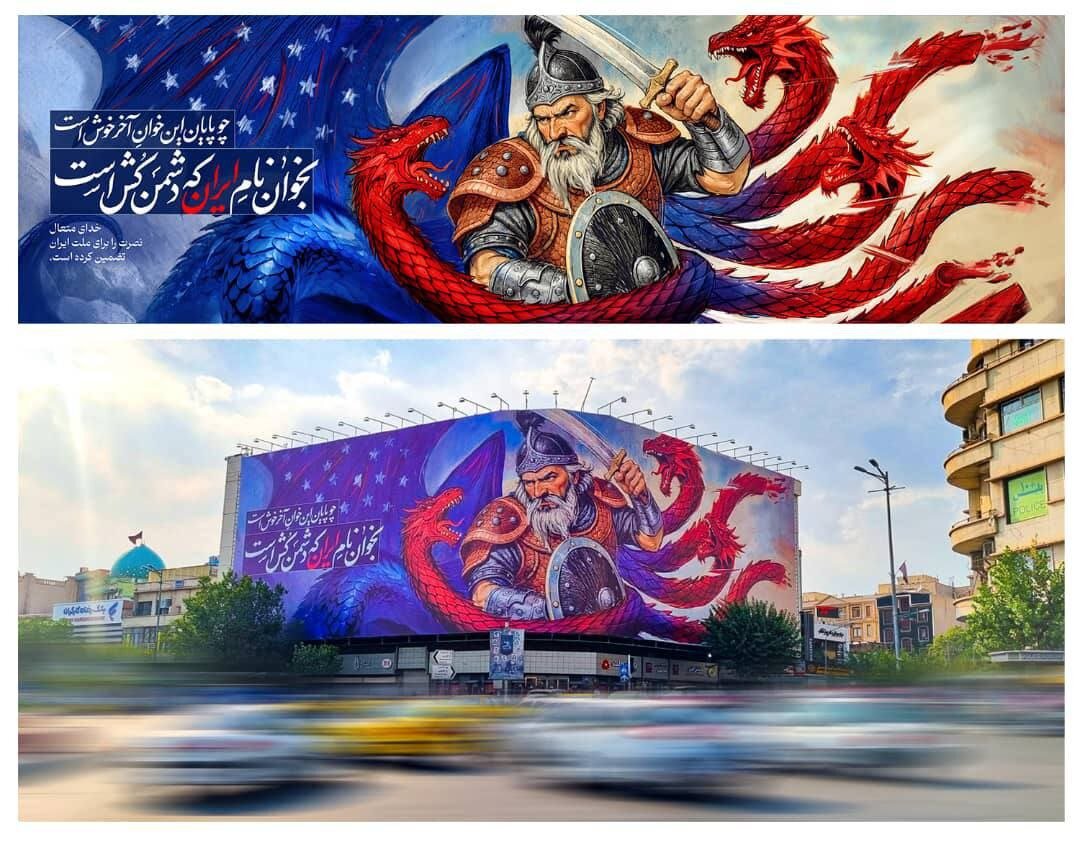Enghelab Square mural depicting Rostam’s battle with dragon symbolizing U.S.

TEHRAN - The new mural in Tehran’s Enghelab Square features a design showing Rostam in combat with a multi-headed dragon symbolizing the United States.
A verse is inscribed on the mural: “As the end of this final quest brings cheer, Sing the name of Iran, the foe-slayer,” Mehr reported.
This verse is written in a style and tone reminiscent of Ferdowsi’s poetry in the Shahnameh (The Book of Kings).
Inspired by Ferdowsi’s epic style, it is crafted for the mural to align with the image of Rostam and the nationalistic atmosphere.
Rostam is the legendary hero of Persian mythology, the central figure in Shahnameh—the Persian national epic composed by Ferdowsi in the 10th–11th century CE. Rostam embodies values like courage, loyalty, and national strength, often depicted in mythical battles against powerful foes such as demons (divs), traitors, and dragons.
The Shahnameh by Ferdowsi is a cornerstone of Persian literature and identity, chronicling the mythical and historical past of Iran from the creation of the world until the Arab conquest in the 7th century. Through poetic storytelling, it promotes themes of justice, heroism, and resistance against oppression.
In this mural, the United States is portrayed as a dragon, a classic foe in Persian myth, symbolizing chaos, destruction, and foreign threat. Rostam’s confrontation with it is a metaphor for Iran’s resistance against U.S. policies, especially in the context of ongoing political and ideological tensions. The imagery transforms a mythological battle into a modern political allegory, framing Iran (as embodied by Rostam) as heroic, noble, and defiant in the face of a powerful adversary.
The inclusion of Ferdowsi’s verse reinforces the nationalistic tone, calling upon historical pride and the idea that Iran has always overcome its enemies.
Another sentence inscribed on the mural reads: “The Almighty God has guaranteed victory for the Iranian nation”.
This statement was made by Leader of the Islamic Revolution Ayatollah Seyyed Ali Khamenei two weeks ago during a meeting with officials of the Judiciary.
The portrayal of the United States as an enemy of Iran is deeply rooted in decades of geopolitical conflict, ideological opposition, and historical trauma.
The U.S. has imposed multiple rounds of economic sanctions on Iran, targeting banking, oil, trade, and even medicine. These sanctions are seen by many Iranians as acts of economic warfare, harming ordinary people and undermining national development. The Trump administration’s withdrawal from the 2015 Iran nuclear deal (JCPOA) and the “maximum pressure” campaign intensified this perception of hostility.
The U.S. military presence in the Middle East (especially in Iraq, Syria, and the Persian Gulf), its close alliance with Israel, and the targeted killing of General Qasem Soleimani in 2020 all reinforce the Iranian view of the U.S. as a direct and dangerous adversary.
Moreover, on June 22, the United States bombed Iranian nuclear facilities during the 12-day Iran-Israel war. From the Iranian leadership’s perspective, these actions confirm that the U.S. and its allies will go to great lengths—even risking regional war—to block Iran’s technological and geopolitical rise.
SS/
